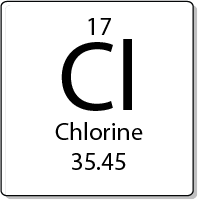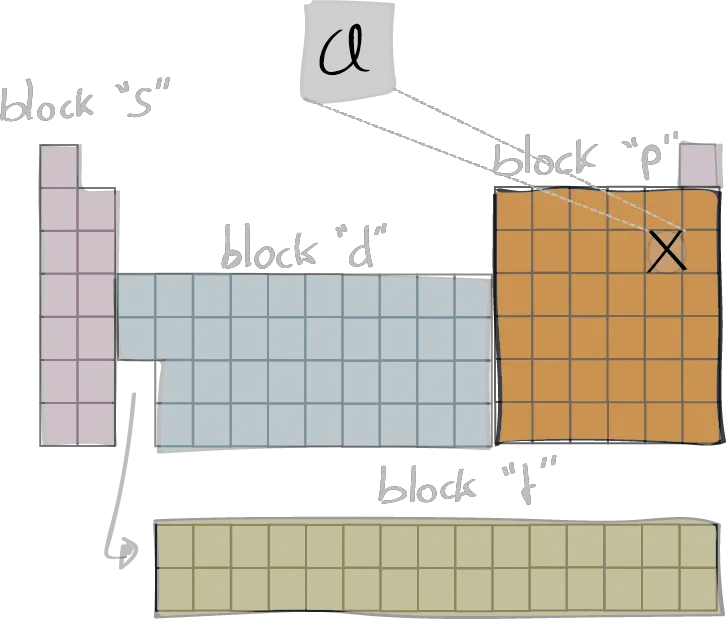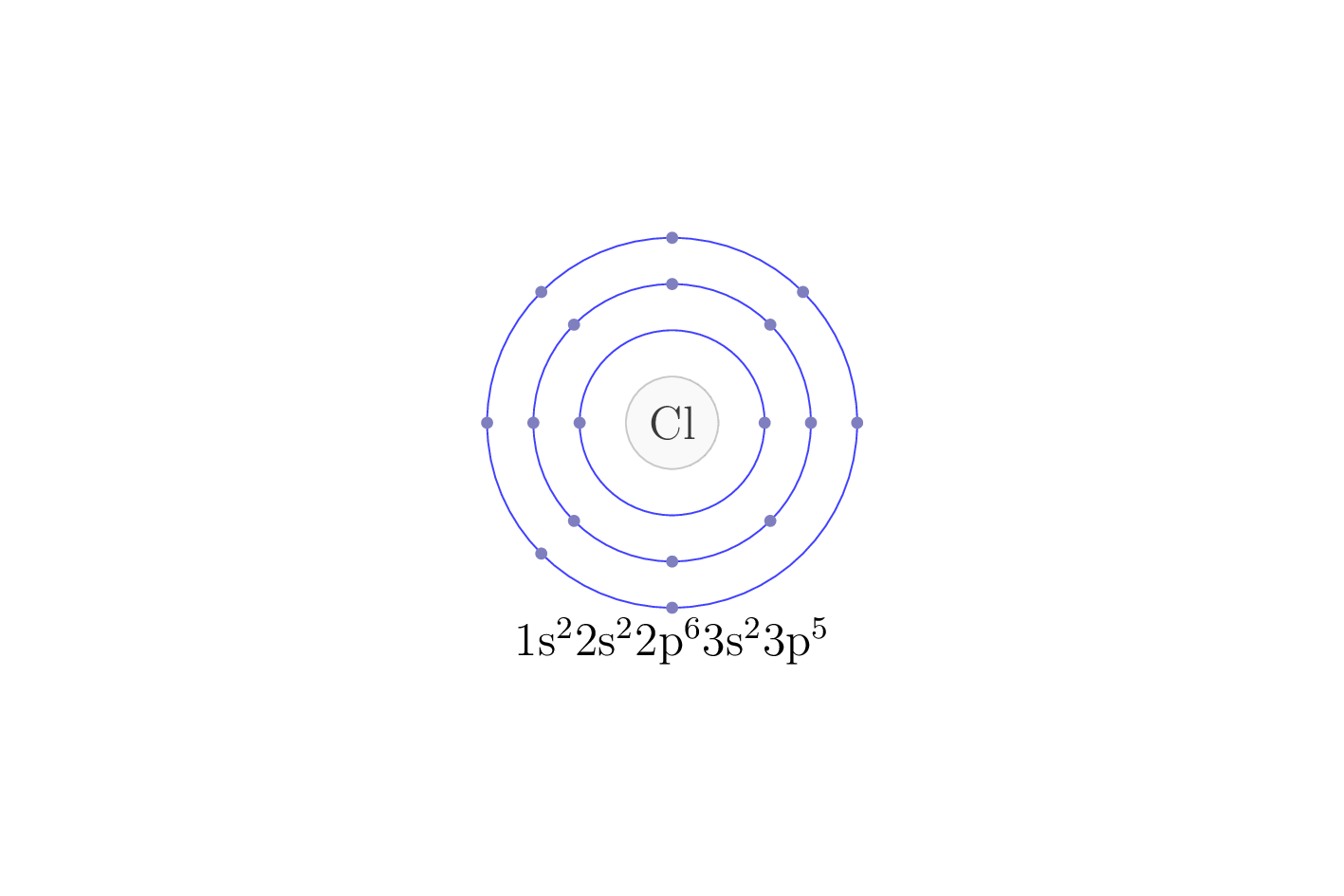
Chlorine is a chemical element with the symbol Cl and atomic number 17. It is a highly reactive, yellow-green gas that belongs to the halogen group in the periodic table. It is highly reactive and forms compounds with almost all other elements.
Chlorine is named after the Greek word chlóros, meaning “pale green“, and refers to the color of this gaseous element. It is a highly reactive gas that forms compounds, and does not exist in pure form in nature. The most common chlorine compound is sodium chloride, NaCl (in nature as the mineral halite, or rock salt).
Chlorine compounds are important to the body and used by muscles and nerves. They are also present in sweat. Chlorine in its pure form is poisonous, and was used in World War I, as a weapon (soldiers had to wear masks to protect themselves from chlorine gas, Cl2).
Today, chlorine is used in many other ways. For example, its compounds are present in many materials, from slippers to chloroform, CHCl3. It reacts with hydrogen to form hydrochloric acid, HCl, an industrial cleaner. This acid is a corrosive liquid that corrodes most metals, releasing hydrogen gas. Sodium hypochlorite is used to clean water in swimming pools, while bleaches and other cleaners use chlorine compounds to kill germs. One of the most widely used plastics, polyvinyl chloride (PVC), contains chlorine. It is a tough plastic, used to make many rigid objects.

Electron configuration
The electron configuration of an element describes the arrangement of electrons in the atoms of that element, and be used to predict its chemical properties and reactivity.
In the electron configuration notation, the letters "s", "p", "d", and "f" represent the different types of atomic orbitals, and the superscripts indicate the number of electrons in each orbital. The orbitals are filled in a specific order, starting with the lowest energy orbital and working up.

Emission spectra
Each element in the periodic table presents its own unique emission spectra, which is determined by the energy levels of its electrons. When an electron in an atom is excited to a higher energy level, it can de-excite by emitting a photon of light with an energy equal to the difference between the two levels. This results in a characteristic emission line in the spectra (which corresponds to specific wavelengths of light). These spectra are usefull to identify the elements present in a sample.

Symmary of properties (Cl)
| Atomic weight | [35.446, 35.457] |
| Discoverer (year) | Scheele, Carl Wilhelm (1774) |
| Natural form | gas (Cl2) |
| Electron configuration | [Ne] 3s2 3p5 |
| M.p. (ºC) | -101 |
| B.p. (ºC) | -35 |
| Earth's crust abundance (ppm) | 145 |
| Isotope (abundance %) | 35Cl (75.76), 37Cl (24.24) |
| Density (g/cm3) | 3.21 |
| vdW radius (pm) | 175 |
| Covalent radius (pm) | 100 |
| Electronegativity (Pauling) | 3.16 |
| Vaporisation enthalpy (Kj/mol) | 20.4º |
| Fusion enthalpy (kJ/mol) | 6.40 |
| Specific heat capacity (J/g·K) at 25ºC and 1 at | 0.48 |
| Thermal conductivity (W/cm·K) at 25 ºC and 1 at | <0.001 (Cl2) |
| Oxidation number | +7, +5, +1, -1 |
| Electronic affinity (eV) | 3.61 |
| 1st Ionization energy (eV) | 12.9676 |
Definition of terms in the previous table
- Atomic weight: The average mass of an element's atoms, typically given in atomic mass units (amu).
- Natural form: The most stable and abundant form of an element that occurs naturally in the environment.
- Electron configuration: The arrangement of electrons in an atom or molecule.
- Melting point: The temperature at which a solid substance turns into a liquid.
- Boiling point: The temperature at which a liquid substance turns into a gas.
- Earth's crust abundance (ppm): The concentration of an element in the Earth's crust, typically given in parts per million (ppm).
- Isotope (abundance %): A variant of an element that has the same number of protons in the nucleus, but a different number of neutrons. The abundance of an isotope is the percentage of the isotope in a sample of the element.
- Density (g/cm3): The mass of a substance per unit volume.
- vdW radius (pm): The radius of an atom or molecule as predicted by the van der Waals model, typically given in picometers (pm).
- Covalent radius (pm): The distance from the center of an atom to the center of another atom with which it is bonded covalently, typically given in picometers (pm).
- Electronegativity (Pauling): A measure of an atom's ability to attract electrons in a chemical bond, based on the Pauling scale.
- Vaporisation enthalpy (kJ/mol): The amount of energy required to convert a substance from a liquid to a gas at a constant temperature.
- Fusion enthalpy (kJ/mol): The amount of energy required to convert a substance from a solid to a liquid at a constant temperature.
- Specific heat capacity (J/g·K) at 25ºC and 1 at: The amount of heat required to raise the temperature of 1 gram of a substance by 1 degree Celsius at a constant pressure.
- Thermal conductivity (W/cm·K) at 25 ºC and 1 at: The ability of a substance to conduct heat, typically given in watts per centimeter per kelvin.
- Oxidation number: A positive or negative integer that represents the number of electrons that an atom has gained or lost in a chemical compound.
- Electronic affinity: The energy change associated with adding an electron to a neutral atom to form a negative ion.
- 1st Ionization energy: The energy required to remove the most loosely bound electron from a neutral atom.